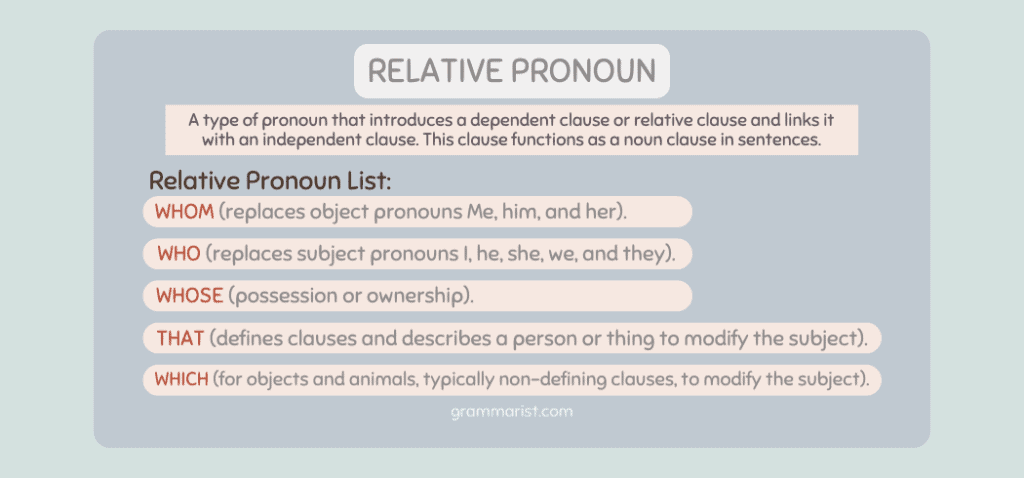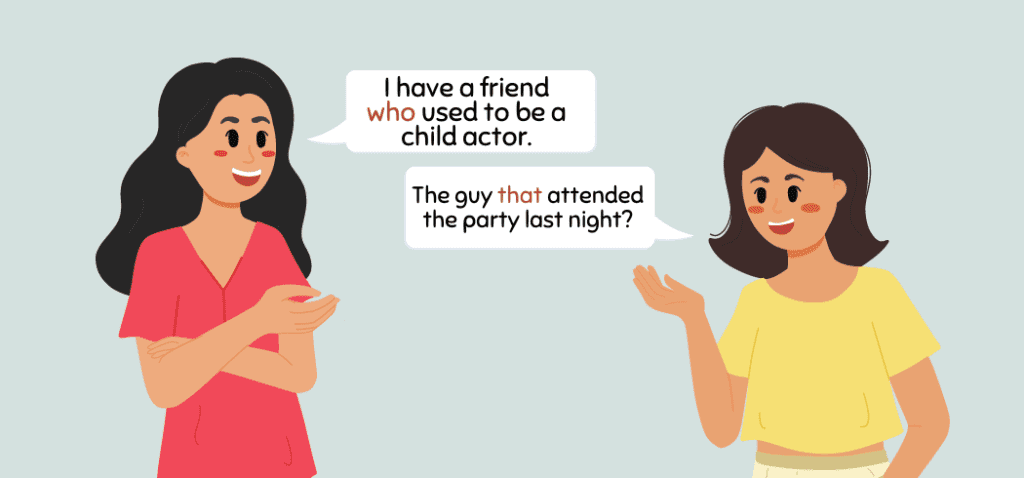A pronoun is a part of speech that renames a noun or noun phrase. One type of pronoun is the relative pronoun.
Learn all about the definition and correct usage of relative pronouns. I also whipped up some examples of how to use them in sentences.
What is a Relative Pronoun?

A relative pronoun in the English language is a type of pronoun that introduces a dependent clause or relative clause and links it with an independent clause. This clause functions as a noun clause in sentences.
Dependent clauses are clauses, meaning a group of words with a subject and predicate that can’t stand on their own as a sentence. Independent clauses are clauses with a subject and predicate that can stand on their own.
Here’s a relative pronoun list to remember.
- Whom (replaces object pronouns Me, him, and her).
- Who (replaces subject pronouns I, he, she, we, and they).
- Whose (possession or ownership).
- That (defines clauses and describes a person or thing to modify the subject).
- Which (for objects and animals, typically non-defining clauses, to modify the subject).
Some grammarians also consider whoever and whomever relative pronouns. These pronouns refer to a person or persons in general.
Other types of pronouns include demonstrative pronouns, possessive pronouns, reciprocal pronouns, indefinite pronouns, interrogative pronouns, personal pronouns, reflexive pronouns, intensive pronouns, and more.
What are the Three Types of Relative Pronouns?
While there are five known relative pronouns, I can actually divide them into three. Learn the types of relative pronouns to avoid mistakes in writing.
Common Relative Pronouns
The word Who is a relative pronoun referring to a person in the subjective form. For example:
- The chef who cooked this risotto deserves his own restaurant.
The word Whom refers to a person as the verb’s object. For example:
- I don’t know to whom this book belongs.
- The girl for whom he got flowers is Janelle.
In the sentences that use whom, you’ll notice that the relative clauses are the objects of verbs.
Which refers to an animal or object. For example:
- Self-help books, which I find helpful, are so expensive.
The word That refers to a person, animal, or thing. For example:
- I want to visit the store that sells organic products.
Relative Possessive Pronoun
Whose is the possessive form of the pronouns who and which. Use it to show possession by people and animals.Consider these examples to understand the possessive meaning of whose.
- The elderly whose spooky house is being renovated is very happy.
- I asked for advice from the neighbor whose type of house is suitable for pet animals.
You might think that which is better for things instead of people. However, this sentence construction can be awkward. You can also use whose for an animal or inanimate object in formal styles but not for informal styles. Consider the sentence below.
- Incorrect: I bought a purse which has genuine leather (sounds awkward).
Correct: I bought a purse whose leather is genuine.
Compound Relative Pronouns
Compound relative pronouns apply to all people, things, and animals. Whoever, whomever, whatever, and whichever are compound relative pronouns. For example:
- Tell whoever visits that I’m not around.
How to Use Relative Pronouns

The different uses of relative pronouns can be confusing. Some writers experience difficulty using the correct pronoun and whether to add a comma or not. Here are some rules to remember.
Who vs. That
Use the word who when you’re referring to a person in the subjective form. For example:
- I have a friend who used to be a child actor.
Here, the relative clause who used to be a child actor modifies the noun friend.
It’s not recommended to use that for a person. But you can use it to refer to a class of people. Here are some relative pronoun examples using that for nonhumans.
- The team of students that went to the game was enthusiastic.
- The family that attended the Christmas gala sat beside a famous person.
Subject-Verb Agreement
A relative pronoun used as a subject follows a specific form of verb, whether singular or plural. For example:
- A fruit that contains vitamin C is nutritious.
- Fruits that contain vitamin C are nutritious.
Which vs. That
That and which start two different types of adjective clauses. These include essential clauses and non-essential clauses. Other terms are restrictive and non-restrictive clauses or defining and non-defining relative clauses.
That indicates a clause that is restrictive to the sentence’s intended meaning. That’s because it identifies the noun it refers to. For example:
- I wore the sweater that you got me.
If you remove the relative clause from the sentence, the sentence reads I wore the weather. The original sentence or complete sentence has a different meaning from the new one.
Which is used in a non-essential clause for an unnamed animal and things. It gives secondary information about the noun it refers to. For example:
- I wore the sweater you gave me, which was from Italy.
Commas
Use a comma to separate a non-restrictive subordinate clause that starts with a relative pronoun. But for restrictive clauses, you shouldn’t use commas. For example:
- The book that my mother gave me is historical fiction.
- The book, which is expensive, is historical fiction.
Some style guides do not require commas. But it’s much better to add one if you’re unsure about your formal writing style or genre.
Which as a Subject and Object
Which can be a subject or object of a clause, unlike who and whom. Here are some examples.
- The gym, which belongs to Mary, has a boxing ring. (which as a subject).
- It’s the only gym which has a boxing ring (which as an object).
That After Superlatives
We typically use the relative pronoun that after superlatives. For example:
- That tournament was the best tennis game that I’ve ever watched in my entire life.
Removing Relative Pronouns
You can remove the relative pronoun in informal styles. But this is only recommended in essential clauses or when the pronoun is the verb’s object. Consider this example.
- Formal: Spanish is a language which I find challenging to learn.
Informal: Spanish is a language I find challenging to learn.
You can also remove the relative pronoun when it is the preposition’s complement. When you follow this method, put the preposition at the end of the clause. For example:
- Formal: I read the poem which you were telling me about (or I read the poem about which you were telling me).
Informal: I read the poem you were telling me about.
When, Where, Why
We use where, why, and when as relative pronouns in informal language to introduce defining clauses. Here are some examples.
- I know a place where we can take good pictures.
- Only Lisa knows the reason why Ron was absent.
- There isn’t a day when I don’t think about my future.
A writing tool like Grammarly or Ginger might recommend making your language concise by removing the pronoun. For example, you can just say, Only Lisa knows the reason Ron was absent.
Cleft Sentences
A cleft sentence is one of the many kinds of sentences cleft to put focus on one part of it. If a cleft sentence has a relative pronoun, it is restrictive. For example
- It was Gigi who used to be the manager.
Examples of a Relative Pronoun in Sentences
- The house that my friend built is lovely.
- My childhood friend who went to London is finally back.
- Her favorite books, which included art books and cookery books, are hidden in a drawer.
- I saw the professor whom you found friendly.
- I met Lisa, whose hair is blonde.
Relative Pronouns in a Nutshell
I hope this guide on relative pronoun definition and its uses helps you avoid writing issues.
Remember that a relative pronoun starts a noun clause to connect a noun with an adjective clause and provides extra information about nouns in sentences. A nonessential clause is set off in the sentence by commas, while an essential clause is not.